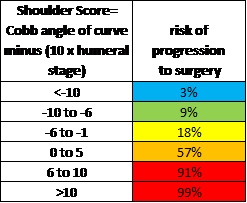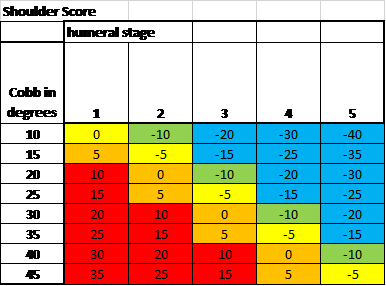

Using Humerus Ossification and Cobb Angle to Predict Progression to Surgery in Scoliosis Patients
Patients with scoliosis, their families and doctors want to know whose curve will get bigger and need surgery. The authors of this study previously found the shape of the humeral ossification center (the growth plate by the shoulder at the top of the humerus bone) predicted when a patient is growing the fastest. This is called peak height velocity. This is when scoliosis is at the greatest risk of getting worse. They divided the shape of the growth plate into 5 stages to help predict how much more growing someone had.
Humeral Ossification Stages:

They looked at scoliosis patients over a 10-year period. All either had surgery or reached skeletal maturity and finished growing without surgery. Surgery for scoliosis is considered for patients with a curve of Cobb angle of 50 degrees. The Cobb angle is how we measure size of the curve. They found younger patients with larger curves were more likely to have curves that needed surgery than smaller curves in older patients.
They developed a formula using the Cobb angle and shoulder growth plate stage to predict which curves might get large enough to need surgery. The Shoulder Score is Cobb angle minus 10 times the humerus stage. This score can help predict if someone with scoliosis will progress to needing surgery.
Here are two tables from the talk:


Summary provided by the SRS Patient Education Committee